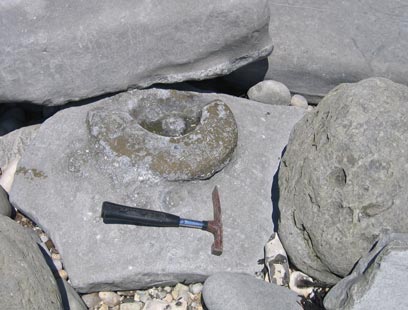The Geology Hammer – a Useful Piece of Field Equipment
Although a geological hammer is often useful, much study of fossils can be done without the use of one. When team members visit places such as Lyme Regis and Charmouth on the Dorset (Jurassic) coast we are often amazed at the number of people that we see bashing away at rocks with hammers. Indiscriminate hammering is a form of vandalism and can be dangerous. Parts of the shoreline at Lyme Regis are strewn with sharp rock fragments which can make crossing the area with bare feet a risky business for any unwary holiday maker.
Geology Hammer
Whilst we appreciate the desire to break open nodules to see if an Ammonite is present, this sort of work should really be done by those people who know what they are doing and are equipped to carry out such procedures. There are certain tell tale signs that can indicate whether a rock may be worth splitting to see if there is a fossil inside it. On many sites hammering is forbidden or even illegal and there is a high risk of damaging a specimen when trying to extract it. Sometimes it can be almost as rewarding to leave a specimen in situ so that others may view it, besides hammering away at rocks can be dangerous. Shards and splinters may break off, so it is always a good idea to wear a pair of safety goggles, if you attempt to split any rocks apart.
A Geological Hammer – Helpful for Finding Fossils
Picture credit: Everything Dinosaur
Ideal for Breaking Rocks
An ordinary DIY hammer should not be used for rock breaking, or at least is should only be used on the softest of sediments such as loose shales and mudstones. The metal used in the manufacture of ordinary hammers is too brittle and chips may fly off (another good reason to wear safety glasses). Geological hammers are made of specially hardened steel and come in various shapes and sizes. These hammers have been specifically designed to cope with the rigours of hitting and splitting rocks.
Whether you are an accomplished fossil hunter of just starting out it can be difficult to obtain advice and to find the equipment you need. When it comes to geological and palaeontological supplies we use a company called GEO Supplies Limited, based in Sheffield, England. Over the years, team members have purchased a number of items from them, we have never encountered a problem and they have always be most helpful.
For further information and advice: Contact Everything Dinosaur.







Leave A Comment